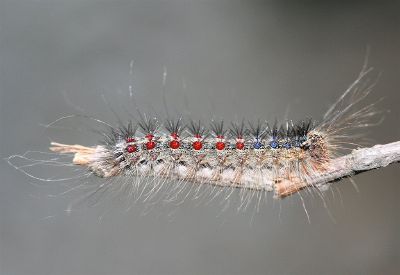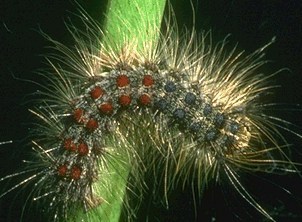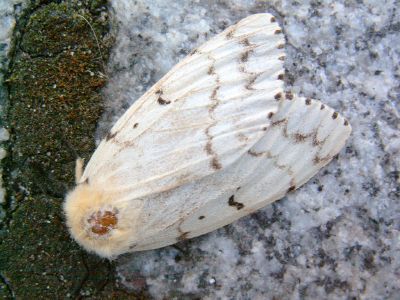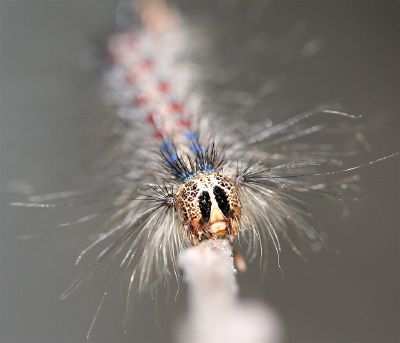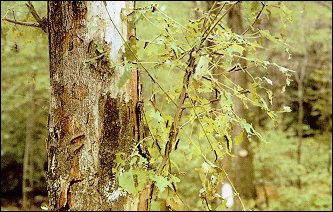Gypsy moth
| Lymantria dispar | ||||||||||||||||||||||
|---|---|---|---|---|---|---|---|---|---|---|---|---|---|---|---|---|---|---|---|---|---|---|
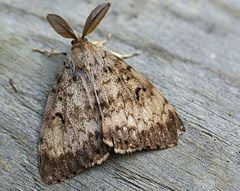 Adult male moth
| ||||||||||||||||||||||
| Scientific classification | ||||||||||||||||||||||
| ||||||||||||||||||||||
| Lymantria dispar Linnaeus, 1758 |
Gypsy moth (also known as the Spongy moth) is the common name for a type of tussock moth, Lymantria dispar that is native to Europe and Asia but has become a serious pest in North America after its introduction in the nineteenth century.
In their natural environment, where spongy moths have developed in harmony with numerous predators, they are part of the balance of nature. They serve as prey species for such animals as predatory and parasitic insects (wasps, ground beetles, etc.), spiders, birds, and mammals such as mice, shrews, and squirrels.
However, the introduction of spongy moths by humans into North America has proven very destructive, with millions of acres of trees defoliated, including both evergreen and deciduous trees, and many trees weakened or killed by repeat infestations. Over one million acres (4,000 km²) of forest each year were defoliated between 1980 and 1991, and in 1981 almost 13 million acres were defoliated (52,200 km²) (McManus et al. 2022). There remain important North American predators, some of which are drawn to infestations. Nonetheless, this introduction remains a significant threat, with concern about spreading to new areas, and outbreaks requiring a massive amount of money and effort to contain. Awareness of such problems, however, has lead to greater quarantine laws and efforts to restrict the introduction of invasive species between nations.
Etymology
The name Lymantria dispar is composed of two Latin-derived words. The generic name Lymantria means 'destroyer.' The species epithet dispar means 'to separate' in Latin; it refers to the sexual dimorphism observed in the male and female imagines.
In July 2021 the Entomological Society of America decided to remove the name "gypsy moth" from its Common Names of Insects and Related Organisms List as "hurtful to the Romani people," since gypsy is considered an ethnic slur by some Romany people in North America. In January 2022, the new common name "spongy moth" was proposed, as a translation from the French name "spongieuse" for the species, referring to the sponge-like egg masses laid by L. dispar.
Description
The spongy moth, Lymantria dispar, is a member of the Lymantriidae family of the insect order Lepidopera (butterflies and moths). Lymantriidae (or Liparidae) includes about 350 known genera and over 2,500 known species found all over the world, in every continent except Antarctica.
Adult moths of this family do not feed. They usually have muted colors (browns and grays), although some are white, and tend to be very hairy. Some females are flightless, and some have reduced wings. Usually the females have a large tuft at the end of the abdomen. The males, at least, have tympanal organs (Scoble, 1995). They are mostly nocturnal, but Schaefer (1989) lists 20 confirmed diurnal species and 20 more likely diurnal species (based on reduced eye size). Spongy moths are diurnal.
The larvae of the Lymantriidae family are also hairy, often with hairs packed in tufts, and in many species the hairs break off very easily and are extremely irritating to the skin. This highly effective defense serves the moth throughout its life cycle as the hairs are incorporated into the cocoon, from where they are collected and stored by the emerging adult female at the tip of the abdomen and used to camouflage and protect the eggs as they are laid. In others, the eggs are covered by a froth that soon hardens, or are camouflaged by material the female collects and sticks to them (Schaefer, 1989).
In the larvae of some species, hairs are gathered in dense tufts along the back and this gives them the common name of tussocks or tussock moths.
Adult moths are sexually dimorphic, with males light to dark brown with irregular black markings, and females all white with irregular black lines on the wings (Grzimek et al. 2004). Males, which are active fliers, have a wingspan of about 1 to 1.5 inches (25.4 to 38 millimeters), while females, which do not fly (except for the larger Asian variety) have a wingspan of about 2.24 to 2.68 inches (56 to 67 millimeters (Grzimek et al. 2004).
Older larvae can be identified by the presence of five pairs of raised blue spots followed by six pairs of raised brick-red spots along their backs, and a sprinkling of setae.
The normal range of these moths is in the palearctic zone, with the exception of the extreme south or north (Grzimek et al. 2004). The Palearctic includes the terrestrial ecoregions of Europe, Asia north of the Himalaya foothills, northern Africa, and the northern and central parts of the Arabian Peninsula. The spongy moth is now in North America as a result of being an introduced species.
Lymantria means "defiler," and spongy moths, as with some other members in Lymantriidae and in Lymantria, are important defoliators of forest trees.
Life cycle
As with other moths, spongy moths undergo complete metamorphosis. Complete metamorphosis, also called holometabolism and complex metamorphosis, is a term applied to those processes in which the larvae differ markedly from the adults. Insects that undergo holometabolism start as an egg, pass through a larval stage (known as a caterpillar), then enter an inactive state called pupa (chrysalis), and finally emerge as adults (imago).
In the spongy moth, there is one generation per year.
Eggs
spongy moth egg masses are typically laid on branches and trunks of trees, but egg masses may be found in any sheltered location. During outbreaks, the moths have been known to lay their eggs on the ships. Four to six weeks later, embryos develop into larvae.
The egg is the overwintering stage. After an acclimation stage, eggs can withstand freezing temperatures. The longer they are chilled in winter, the less heating is required for their hatch in spring.
Egg masses are buff colored when first laid but may bleach out over the winter months when exposed to direct sunlight and weathering. As the female lays them, she covers them with hair-like setae from her abdomen. Many individuals find these hairs irritating, and they may offer the eggs some protection. Egg masses contain from a couple of hundred to about 1200 eggs.
Larvae
The hatching of spongy moth eggs coincides with budding of most hardwood trees. Larvae (caterpillars) emerge from egg masses from early spring through mid-May.
Spongy moths are dispersed in two ways. Natural dispersal occurs when newly hatched larvae hanging from host trees on silken threads are carried by the wind for a distance of up to about 1 mile, although most go less than 50 meters. Eggs can be carried for longer distances. Artificial dispersal occurs when people transport spongy moth eggs thousands of miles from infested areas on cars and recreational vehicles, firewood, household goods, and other personal possessions. Females are flightless in most varieties, so these are the only means of spreading.
Larvae develop into adults by going through a series of progressive molts, through which they increase in size. Instars are the stages between each molt. Male larvae normally go through five instars (and females, six) before entering the pupal stage. Newly hatched larvae are black with long hair-like setae.
During the first three instars, larvae remain in the top branches or crowns of host trees. The first stage or instar chews small holes in the leaves. The second and third instars feed from the outer edge of the leaf toward the center. Older larvae have the characteristic blue (5 pairs) and red (6 pairs) of spot on their dorsal surface.
When population numbers are sparse, the movement of the larvae up and down the tree coincides with light intensity. Larvae in the fourth instar feed in the top branches or crown at night. When the sun comes up, larvae crawl down the trunk of the tree to rest during daylight hours. Larvae hide under flaps of bark, in crevices, or under branchesâany place that provides protection. When larvae hide underneath leaf litter, mice, shrews, and Calosoma beetles can prey on them. At dusk, when the sun sets, larvae climb back up to the top branches of the host tree to feed.
When population numbers are dense, however, larvae feed continuously day and night until the foliage of the host tree is stripped. Then they crawl in search of new sources of food.
Pupae
The larvae reach maturity between mid-June and early July and then enter the pupal stage. This is the stage during which larvae change into winged adults. Pupation lasts from 7 to 14 days. When the population is spread out and running low, pupation can take place under flaps of bark, in crevices, under branches, on the ground, and in other places where larvae rested. During periods when population numbers are dense, pupation is not restricted to locations where larvae rested. Pupation will take place in sheltered and non-sheltered locations, even exposed on the trunks of trees or on foliage of nonhost trees. Usually the caterpillars create flimsy cocoons made of silk strands holding the leaf together, while others do not cover their pupae in cocoons, but rather hang from a twig or tree bark, like butterfly pupae do.
Adults
The brown male spongy moth, upon emerging, flies in rapid zigzag patterns searching for females. The malespongy moths are diurnal unlike most moths, which are nocturnal. When heavy, black-and-white egg-laden females emerge, they emit a chemical substance called a pheromone that attracts the males. After mating, the female lays her eggs in July and August close to the spot where she pupated. Then, both adult moths die.
The European and most Russian forms of the spongy moth have flightless females. Although they have large wings, the musculature is not developed. However, the Japanese spongy moth females do fly and are attracted to lights.
Spongy moths (at least of the introduced American population) fly all day and night, with the possible exception of the late morning. They are most active soon after dusk and in the latter hours of the night (Fullard and Napoleone 2001).
North American introduction
The spongy moth was introduced into the United States in 1868 by a French scientist, Leopold Trouvelot, living in Medford, Massachusetts. The native silk spinning caterpillars were proving to be susceptible to disease. So Trouvelot brought over spongy moth eggs to try and make a caterpillar hybrid that could resist diseases. When some of the moths escaped from his lab, they started to multiply. They eventually grew to be spongy moths as we know them today.
It is now one of the most notorious pests of hardwood trees in the Eastern United States. The first outbreak there occurred in 1889. By 1987, the spongy moth had established itself throughout the Northeast USA and southern Quebec and Ontario. The insect has spread south into Virginia and West Virginia, and west into Michigan, Wisconsin, and Minnesota.
Some spongy moths were likewise introduced into the northwestern North America in 1991. Small, isolated infestations have occurred sporadically in Utah, Oregon, Washington, California, and British Columbia, but these have all been successfully eradicated.
Between 1980 and 1991, the spongy moth defoliated over 1,000,000 acres (4,000 km²) of forest each year (McManus et al. 2022). In 1981, a record 12,900,000 acres (52,200 km²) were defoliated. This is an area larger than Rhode Island, Massachusetts, and Connecticut combined.
In wooded suburban areas, during periods of infestation when trees are visibly defoliated, spongy moth larvae crawl up and down walls, across roads, over outdoor furniture, and even inside homes. During periods of feeding they leave behind a mixture of small pieces of leaves and excrement. During outbreaks, the sound of chewing and excrement dropping is a continual sound.
Spongy moth populations usually remain at very low levels but occasionally populations increase to very high levels which can result in partial to total defoliation of host trees for one to three years.
Hosts
Spongy moth larvae generally prefer oaks, but may feed on several hundred different species of trees and shrubs, both hardwood and conifer. In Eastern North America, the spongy moth prefers oaks, aspen, apples, sweetgum, speckled alder, basswood, gray and paper birch, poplars, willows, and hawthorns, although other species are also affected. The list of hosts will undoubtedly expand as the insect spreads south and west. The spongy moth avoids ash trees, tulip-tree, American sycamore, butternut, black walnut, catalpa, flowering dogwood, balsam fir, arborvitae, American holly, and shrubs such as mountain laurel and rhododendrons, but will feed on these in late instars when densities are extremely high. Older larvae feed on several species of hardwood that younger larvae avoid, including cottonwood, hemlock, Atlantic white cypress, and the pines, and spruces native to the East.
Defoliation of trees
The effects of defoliation depend primarily on the amount of foliage that is removed, the condition of the tree at the time it is defoliated, the number of consecutive defoliations, available soil moisture, and the species of host.
If less than 50 percent of their crown is defoliated, most hardwoods will experience only a slight reduction (or loss) in radial growth.
If more than 50 percent of their crown is defoliated, most hardwoods will refoliate or produce a second flush of foliage by midsummer. Healthy trees can usually withstand one or two consecutive defoliations of greater than 50 percent. Trees that have been weakened by previous defoliation or been subjected to other stresses such as droughts are frequently killed after a single defoliation of more than 50 percent.
Trees use energy reserves during refoliation and are eventually weakened. Weakened trees exhibit symptoms such as dying back of twigs and branches in the upper crown and sprouting of old buds on the trunk and larger branches. Weakened trees experience radial growth reduction of approximately 30 to 50 percent.
Trees weakened by consecutive defoliations are also vulnerable to attack by disease organisms and other insects. For example, the Armillaria fungus attacks the roots, and the two-lined chestnut borer attacks the trunk and branches. Affected trees will eventually die two or three years after they are attacked.
Although not preferred by the larvae, pines and hemlocks (as the term is used in North America) are subject to heavy defoliation during spongy moth outbreaks and are more likely to be killed than hardwoods. A single, complete defoliation can kill approximately 50 percent of the pines and 90 percent of the mature hemlocks. This is because conifers do not store energy in their roots; an exception is larch.
Factors affecting populations
Natural enemies play an important role during periods when spongy moth populations are sparse. Natural enemies include parasitic and predatory insects such as wasps, flies, ground beetles, and ants; many species of spiders; several species of birds, such as chickadees, blue jays, nuthatches, towhees, and robins; and approximately 15 species of common woodland mammals, such as the white-footed mouse, shrews, chipmunks, squirrels, and raccoons. Predation by small mammals (mice and shrews) is the largest source of mortality in low density spongy moth populations and this mortality is apparently critical in preventing outbreaks. Calosoma (ground beetles of European origin), cuckoos, and flocking birds, such as starling, grackles, and red-winged blackbirds, are attracted to infested areas in years when spongy moth populations are dense.
Diseases caused by bacteria, fungi, or viruses contribute to the decline of spongy moth populations, especially during periods when spongy moth populations are dense and are stressed by lack of preferred foliage.
Wilt disease caused by a particular nucleopolyhedrosis virus (NPV) that is specific to the spongy moth is the most devastating of the natural diseases. NPV causes a dramatic collapse of outbreak populations by killing both the larvae and pupae. Larvae infected with wilt disease are shiny and hang limply in an inverted "V" position. Infection with NPV is the most common source of mortality in high density populations, and NPV epizootics usually cause the collapse of populations.
Since the 1980s, the fungus Entomophaga maimaiga has also had a large impact on spongy moth populations in North America.
Weather affects the survival and development of spongy moth life stages regardless of population density. For example, temperatures of -20°F, (-29°C.) lasting from 48 to 72 hours can kill exposed eggs; alternate periods of freezing and thawing in late winter and early spring may prevent the over wintering eggs from hatching; and cold, rainy weather inhibits dispersal and feeding of the newly hatched larvae and slows their growth.
Managing the spongy moth
A number of tactics have the potential to minimize damage from spongy moth infestations and to contain or maintain populations at levels considered tolerable. These tactics include monitoring spongy moth populations, maintaining the health and vigor of trees, discouraging spongy moth survival, and treating with insecticides to kill larvae and protect tree foliage. The tactic or combination of tactics used will depend on the condition of the site and of the tree or stand and the level of the spongy moth population. Tactics suggested for homeowners are probably too costly and too labor intensive for managers to use in forest stands.
The spongy moth currently occupies less than 1/3 of its potential range in North America and considerable resources are directed at minimizing the expansion of its range into these areas. Every year, over 100,000 pheromone traps are placed in uninfested portions of the United States in order to detect new infestations that occasionally arise when people inadvertently transport life stages into uninfested areas (e.g., egg masses on recreational vehicles). When captures are positive for several consecutive years, this indicates that a population is establishing and these populations are eradicated, usually via the application of the bacterial pesticide, Bacillus thuringiensis ('Bt').
Health of trees
- Enhance growth conditions for isolated trees by encircling them with mulch or ground cover plants that do not compete for moisture and nutrients the way dense grass layers do.
- Water the shade and ornamental trees in periods of drought to maximize recovery during refoliation.
- Fertilize shade trees.
- Avoid stressing trees. For example, construction projects tend to compact soil and prevent moisture from penetrating to small feeder roots.
- Avoid applying lime or weed killers around trees. These chemicals can seriously damage shallow tree roots.
- Thin the woodlot trees and groups of shade trees between outbreaks to reduce competition.
Natural control
Spongy moth larvae have several predators/parasites which can help decrease their population. Lack of predation is one reason they can go from a normal part of the ecosystem to an actual threat to trees. Among their predators are:
- deer mice. Deer mice are considered the most important predator of low-density spongy moth populations and their abundance may be critical in determining whether populations go into an outbreak mode. Their abundance is strongly affected by the amount of mast (e.g., acorns) in the previous year.
- tachinid flies. Tachinid flies parasitize spongy moth populations. While they may become quite abundant during a spongy moth outbreak, they apparently have little effect on the population dynamics
- braconid wasps. Braconid wasps also parasitize spongy moths, but play a minor role in their dynamics
There is not any evidence that releasing or enhancing spongy moth predators or parasites can reduce spongy moth populations. Manual removal of spongy moths may be a viable method for reducing damage on small, open-grown trees and shrubs.
Use of pesticides
The decision to use pesticides is influenced by a number of factors:
- The number of visible egg masses.
- The percentage of preferred hosts in a mixed stand of trees (50 percent or more of oak).
- Whether trees already have dead or dying branches, especially near the top branches or crown.
- Whether the property is located adjacent to wooded areas heavily infested with spongy moths.
During periods when numbers of spongy moth larvae are dense, pesticides may be the most effective method of reducing the number of larvae and protecting the foliage of host trees. Application of pesticides should be done by a certified applicator, because special equipment is required. Large areas, such as wooded residential areas and forests, should be treated by aircraft.
Available pesticides fall into two broad groups: microbial or biological and chemical (table 1).
Microbial and biological pesticides contain living organisms that must be consumed by the pest. Microbials include bacteria, viruses, and other naturally occurring organisms; biologicals include manmade synthetics of naturally occurring organisms. These pesticides should be applied before the larvae reach the third stage or instar of development. As they mature, larvae become more resistant to microbial pesticides and are, therefore, more difficult to kill.
Low dose pheromone systems are being employed in some areas (Channel Islands, United Kingdom) to flood areas with synthetic pheromone and effectively "blind" males so they are unable to locate females.
Nucleopolyhedrosis virus (NPV), a naturally occurring organism, has been developed as a microbial pesticide. It is presently registered under the name "Gypchek" and is available for use in USDA Forest Service sponsored suppression programs. NPV and Gypcheck are specific to the spongy moth.
Bacillus thuringiensis (Bt) is microbial and biological. It is the most commonly used pesticide. In addition to being used against the spongy moth, Bt is used against a number of other pests, including the western spruce budworm and other Choristoneura, and tent caterpillars. When Bt is taken internally, the insect becomes paralyzed, stops feeding, and dies of starvation or disease.
Chemical pesticides are contact poisons in addition to being stomach poisons. The timing of the chemical application is less critical to the successful population reduction of the pest than the timing of the application of the microbials and biologicals. Chemical pesticides can affect non-target organisms and may be hazardous to human health.
Table 1 - Microbial and chemical pesticides commonly used for spongy moth control
| Active ingredient | Representative trade names | Remarks |
|---|---|---|
| Bacillus thuringiensis | Dipel Thuricide | Registered for aerial and ground application. Available under a variety of trade names. Toxic to other moth and butterfly larvae. Can be used safely near water. |
| Acephate | Orthene | Registered for aerial and ground application. Available under a variety of trade names. Toxic to bees and some spongy moth parasites. Commonly used from the ground to treat individual trees. |
| Carbaryl | Sevin | Registered for aerial and ground application. Available under a variety of trade names. Toxic to bees and spongy moth parasites. At one time, the most widely used chemical in spongy moth control programs. |
| Diflubenzuron | Dimilin | A restricted-use pesticide that can be applied only by certified applicators. |
The most commonly used chemical pesticides currently registered by the U.S. Environmental Protection Agency (EPA) for use against the spongy moth contain carbaryl, diflubenzuron, and acephate. Malathion, methoxychlor, phosmet, trichlorfon, and synthetic pyrethroids (permethrin) have also been registered by EPA for control of spongy moth, but are used infrequently.
Several studies done by Peter G. Kevan and associates of the University of Guelph, between 1975 and 1995 in eastern Canada have shown serious reduction in blueberry and other crop pollination due to forest aerial applications of insecticides that killed non-target wild bees.
Diflubenzuron represents a new class of pesticides called insect growth regulators. It kills spongy moth larvae by interfering with the normal molting process. Diflubenzuron has no effect on adult insects. Aquatic crustaceans and other immature insects that go through a series of molting stages are often sensitive to this pesticide.
Silvicultural guidelines
Several interrelated factors determine the vulnerability of forest stands and woodlots to spongy moth defoliation. An awareness of these factors will enable land managers and woodlot owners to prescribe silvicultural actions (such as thinning of a stand) that will minimize the impact caused by spongy moth defoliation. Three of these factors include the abundance of favored food species (mainly oaks), site and stand factors, and tree conditions.
Stands of trees that are predominantly oak and grow on poor, dry sites (such as sand flats or rock ridges) are frequently stressed and often incur repeated, severe defoliations. Trees growing under these conditions frequently possess an abundance of structural features such as holes, wounds, and deep bark fissures that provide shelter and habitats for spongy moth larvae and aid their survival.
Stands of trees that are predominantly oak but grow on protected slopes or on sites with adequate moisture and organic matter are more resistant to defoliation by the spongy moth.
Slow-growing trees on poor sites frequently survive a single, severe defoliation better than fast-growing trees typically found on well-stocked better sites.
More trees are killed in stands that contain mainly oak species than in oak-pine or mixed hardwood stands. Subdominant trees are killed more rapidly and more often than dominant trees.
Silvicultural treatment
Appropriate silvicultural treatment will be determined by an anticipated occurrence of spongy moth defoliation, by characteristics of the stand, and by the economic maturity of the stand. Foresters refer to treatments discussed here as "thinnings." Thinnings are cuttings made in forest stands to remove surplus trees (usually dominant and subdominant size classes) in order to stimulate the growth of trees that remain.
Pre-defoliation treatments. When spongy moth defoliation is anticipated, but not within the next five years, pre-defoliation thinning to selectively remove preferred-host trees can reduce the severity of defoliation, increase the vigor of residual trees, and encourage seed production and stump sprouting. Thinnings should not be conducted in fully stocked stands that will reach maturity within the next 6 to 15 years. Thinning results in a short-term "shock effect" to residual trees. This shock effect, coupled with defoliation-caused stress, renders trees vulnerable to attack by disease organisms such as Armillaria.
In fully stocked stands that will reach maturity within the next 16 or more years, two kinds of thinning can be applied. The method of thinning should depend on the proportion of preferred host species present.
If more than 50 percent of the basal area in a stand is preferred host species (mainly oaks), presalvage thinning should be applied. Presalvage thinning is designed to remove the trees most likely to die (trees with poor crown condition) from stress caused by spongy moth defoliation.
If less than 50 percent of the basal area in a stand is in preferred host species, sanitation thinning can be applied to reduce further the number of preferred host trees. This will result in fewer refuges for spongy moth larvae and in improved habitats for the natural enemies of the spongy moth.
Treatment during outbreaks: If defoliation is current or is expected within the next 5 years, thinnings should be delayed because of potential "shock effect." High-value stands can be protected by applying pesticides. In low-value stands or those that are at low risk (less than 50 percent basal area in preferred host species), protective treatments are optional.
Post-outbreak treatments. After a defoliation episode, the land manager or woodlot owner should pursue efficient salvage of dead trees, but should delay decisions about additional salvage, regeneration, or other treatments for up to three years. At the end of three years, most defoliation-caused mortality will be complete and the need for treatments can be assessed on the basis of damage level, current stocking conditions, and stand maturity.
ReferencesISBN links support NWE through referral fees
- Andreadis, T. G., and R. M. Weseloh. 1990. Discovery of Entomophaga maimaiga in North American gypsy moth, "Lymantria dispar." Proceedings of the National Academy of Sciences 87(7): 2461-2465.
- Barbosa, P., and J. Greenblatt. 1979. Suitability, digestibility and assimilation of various host plants of the gypsy moth Lymantria dispar L. (Lepidoptera, Lymantriidae). Oecologia 43(1): 111-119.
- Barbosa, P., M. Waldvogel, and P. Martinat. et al. 1983. Developmental and reproductive performance of the gypsy moth, Lymantria dispar (L) (Lepidoptera, Lymantriidae), on selected hosts common to mid-atlantic and southern forests. Environmental Entomology 12(6): 1858-1862.
- Bogdanowicz, S. M., W. E. Wallner, J. Bell, et al. 1993. Asian gypsy moths (Lepidoptera, Lymantriidae) in North America: Evidence from molecular data. Annals of the Entomological Society of America 86(6): 710-715.
- Dwyer, G., and J. S. Elkinton. 1993. Using simple-models to predict virus epizootics in gypsy-moth populations. Journal of Animal Ecology 62(1): 1-11.
- Elkinton, J. S., W. M. Healy, J. P. Buonaccorsi, G. H. Boettner, A. M. Hazzard, H. R. Smith, and A. M. Liebhold. 1996. Interactions among gypsy moths, white-footed mice, and acorns. Ecology 77(8): 2332-2342.
- Fullard, J. H., and N. Napoleone. 2001. Diel flight periodicity and the evolution of auditory defences in the Macrolepidoptera. Animal Behaviour 62(2): 349â368.
- Gansner, D. A., O. W. Herrick, G. N. Mason, and K. W. Gottschalk. 1987. Coping with the gypsy moth on new frontiers of infestation. Southern Journal of Applied Forestry Research 11: 201-209.
- Gould, J. R., J. S. Elkinton, and W. E. Wallner. 1990. Density-dependent suppression of experimentally created gypsy moth, Lymantria dispar (Lepidoptera, Lymantriidae), populations by natural enemies. Journal of Animal Ecology 59(1): 213-233.
- Liebhold, A. M., J. A. Halverson, and G. A. Elmes. 1992. Gypsy moth invasion in North America: A quantitative analysis. Journal of Biogeography 19(5): 513-520.
- McManus, M. L., D. R. Houston, and W. E. Wallner. 1979. The homeowner and the gypsy moth: Guidelines for control. Home and Gard. Bull. 227: 4-33. U.S. Department of Agriculture, Washington, DC.
- McManus, M., N. Schneeberger, R. Reardon, and G. Mason. [1992] 2022. Spongy moth. Forest Insect & Disease Leaflet 162, U.S. Department of Agriculture Forest Service. Retrieved May 14, 2025.
- Myers, J. H. 1993. Population Outbreaks in Forest Lepidoptera. American Scientist 81: 240-251.
- Podgwaite, J.D. 1979. Diseases of the gypsy moth: How they help to regulate populations. Agric. Handbook 539: 2-15. U.S. Department of Agriculture, Washington, DC.
- Rossiter, M.C. 1991. Maternal effects generate variation in life-history: Consequences of egg weight plasticity in the gypsy moth. Functional Ecology 5(3): 386-393.
- Schaefer, P. 1989. Diversity in form, function, behavior, and ecology. In USDA Forest Service (ed.), Proceedings, Lymantriidae: A Comparison of Features of New and Old World Tussock Moths. 1-19. Broomall, PA.
- Scoble, M. J. 1992. The Lepidoptera: Form, Function and Diversity, 2nd ed. Oxford University Press. ISBN 0198540310
- Weseloh, R. M., and T. G. Andreadis. 1992. Epizootiology of the fungus Entomophaga maimaiga, and its impact on gypsy moth populations. Journal of Invertebrate Pathology 59(2): 133-141.
External links
All links retrieved May 14, 2025.
- 'Spongy Moth' Adopted as New Common Name for Lymantria dispar Entomological Society of America
- Spongy Moth National Invasive Species Information Center, US Department of Agriculture.
- The Spongy Moth's Life Cycle and Related Moths Connecticut Department of Energy & Environmental Protection
- Spongy Moth New York State Department of Environmental Conservation
- Spongy Moths Mass Audubon
- Spongy Moth Life Cycle Michigan State University
Credits
New World Encyclopedia writers and editors rewrote and completed the Wikipedia article in accordance with New World Encyclopedia standards. This article abides by terms of the Creative Commons CC-by-sa 3.0 License (CC-by-sa), which may be used and disseminated with proper attribution. Credit is due under the terms of this license that can reference both the New World Encyclopedia contributors and the selfless volunteer contributors of the Wikimedia Foundation. To cite this article click here for a list of acceptable citing formats.The history of earlier contributions by wikipedians is accessible to researchers here:
The history of this article since it was imported to New World Encyclopedia:
Note: Some restrictions may apply to use of individual images which are separately licensed.
